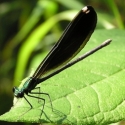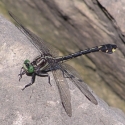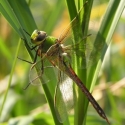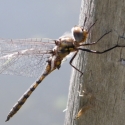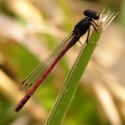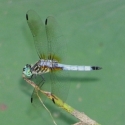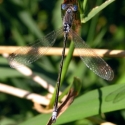Dragonflies / Damselflies
Dragonflies and damselflies belong to the order Odonata. There about 5,500 species worldwide and 430 species in North America. It is one of the largest aquatic insect orders, giving them an important role in aquatic ecosystems. They differ from other insects by having 4 cellophane-like wings of equal length and tiny, bristle-like antennae. The Odonata represent one of the most primitive living insect groups. Protodonata, the probable ancestors of Odonata, lived about 300 million years ago and some had 2 foot wingspans. The closest living relatives are the mayflies. Odonates retain some primitive features such as the inability to fold the wings flat and fanlike over the abdomen, dense wing venation and the fact that each wing is fully functional and independently movable. Odonates do not undergo complete metamorphosis because they skip the pupal stage, with the larva transforming directly into the adult. They are some of the most beneficial insects because they are voracious predators and their main prey species are mosquitoes.
Dragonflies are generally larger and more robust than damselflies. The larvae hatch from eggs laid in water, on aquatic plants or along river banks. Dragonflies spend most of their lives underwater as larvae. The larvae have stout, pointed terminal appendages. When development is complete the larva leaves the water and climbs onto a rock or plant stem to emerge from its larval skin (exuvia) as an adult dragonfly. This is the most dangerous time in its life because it is unable to fly for the first hour or two and is very vulnerable to predation from birds and other insects. The juvenile dragonfly moves away from the water and spends a few weeks feeding until sexually mature when it returns to the water to mate. The male claspers (appendages at the end of the abdomen) are used to capture females for mating. Most male dragonflies have an apparatus which allows them to remove sperm from a female that has been deposited by another male. Since the eggs are actually fertilized by the last male that mates with her, the males in some species guard the female while she is laying eggs to drive away other males. Dragonflies usually perch with the wings straight out to the sides, although a few species hold them downward.
Damselflies are generally smaller and weaker fliers than dragonflies. Most damselflies perch with the wings pressed together over the back, however, the Spreadwings hold them partly spread. Damselfly larvae have terminal appendages that are 3 “leaf-like” gills. Their life stages are the same as for dragonflies.
Disclaimer: The content of NatureSearch is provided by dedicated volunteer Naturalists of Fontenelle Forest who strive to provide the most accurate information available. Contributors of the images retain their copyrights. The point of contact for this page is: Babs Padelford.

